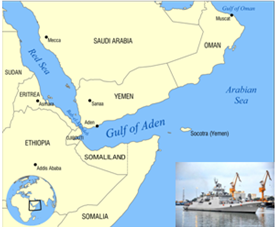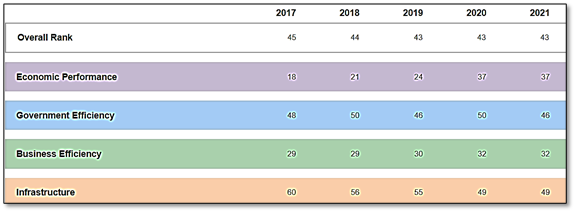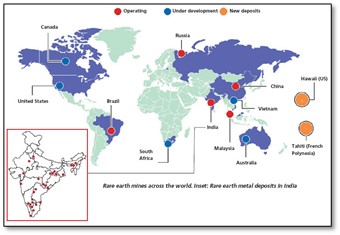Monday, 21st June 2021
End-use restrictions for mines
In News
The mines ministry has amended the mineral auction rules to remove end-use restrictions for mines to be allocated in future through the competitive bidding route.
About the News
- As per the amendment to the Mineral (Auction) Rules, 2015, the state government shall not reserve any mine for captive purpose or any specific end use or partial specific end use in the auction. The decision will cover minerals like iron ore, bauxite, limestone, lead, copper and precious metals.
- The 2015 rules empowered the states to reserve a mine or mines for any particular specified end-use but said that the minerals extracted under the mining lease shall be utilised solely for the specified end-use and not be sold or transferred or otherwise disposed of, either directly or indirectly.
- In the cases of mines already auctioned as captive mines for any particular specified end-use before the commencement of the Mineral (Auction) Second Amendment Rules, 2021, up to 50% of the total mineral produced in such captive mine in a financial year may be sold in open market.
- The new amendments have also suggested the state to intimate to the central government the details of all the areas or mines available with it for auction of composite licence within 45 days of the commencement of the Mineral (Auction) Second Amendment Rules, 2021.

Significance of the Move
- Boost to supplies: The removal of distinction between captive and non-captive mines and their mandatory end-use criteria is likely to augment production for sale in the open market, boosting coal supplies in the country. This is expected to enhance production and attract private investments into the sector.
- Efficient Energy market: The move will help create an efficient energy market, usher in competition, and reduce coal imports, while also ending the monopoly of state-owned Coal India Ltd. India's coal sector was nationalised in 1973.
- Self-reliance: India has the world's fourth-largest coal reserves, yet it imported 235 million tonnes of coal for Rs 1.71 lakh crore last fiscal. This move will go a long way in reducing the Coal Imports which is over $15 billion/year.
- Technology access: The move to amend the law will help India gain access to high-end technology for underground mining used by global miners.
India looks at non-OPEC options to tame oil prices
In News
India is looking for alternative long-term supplies of crude oil from outside the Organization of the Petroleum Exporting Countries (OPEC) to contain oil prices.
Background
- India is witnessing a spike in auto fuel rates due to rising international oil prices. The retail prices of petrol and diesel jumped 27 times in 48 days. One of the key reasons for high domestic fuel rates is production curbs by the oil cartel- the OPEC.
- In wake of demand reduction due to COVID-19, OPEC and its allies, including Russia (together known as OPEC+) have cut their production since May 1, 2020, but did not adhere to the planned supply restoration.
- With rising demand and supply constraints, oil prices have now hit $74.39 a barrel on June 16, 2021, the highest since April 2019.

India’s major sources to import oil
- India is the world’s third largest crude oil importer and imports 84% of its oil requirements. India’s oil import bill in FY20 and FY19 was $101.4 billion and $111.9 billion, respectively.
- Traditionally, Saudi Arabia led OPEC+ have been India’s mainstay suppliers, accounting for 86% of Indian oil imports. However, there has been a shift in these trends in recent times.
- In Fiscal 2020-21, India bought more US and Canadian oil at the expense of that from Africa and the Middle East, reducing purchases from members of the OPEC and squeezing the group's share of imports to 72% from around 80% previously. That is the lowest share of OPEC in at least two decades.
- In February 2021, Iraq remained the top oil supplier to India followed by the US as refiners increased purchase of cheaper US crude by 48% (14% of overall imports) thereby relegating Saudi Arabia to being the fourth largest supplier, and offsetting OPEC+ supply cuts strategy. Nigeria was the third largest oil supplier.
How can the OPEC cartel manipulate crude prices?
- Saudi Arabia-led OPEC which controls 40% of the world’s crude oil, aims to unify petroleum pricing of its members. (Ecuador decided to withdraw its membership of OPEC effective 1 January 2020. So currently OPEC has 13 members)
- As per the terms of the contract, suppliers can reduce supplies when OPEC nations decide to lower production levels to hike crude prices, thereby, refusing to adhere to the contractual price (when price goes up due to production cut).
- For instance, in January 2021, Saudi Arabia pledged additional output cuts of 1 million barrels per day, causing oil prices to spike to $61.22 in February 2021.
- Saudi Oil also comes at a premium (Asian Premium) which makes oil imports further costly.
India’s Alternatives for Oil Imports – Diversification Drive
- The country has already curbed its reliance on the Middle East from more than 64% of imports in 2016 to below 60% in 2019.
- HPCL-Mittal Energy Ltd bought the country's first cargo from Guyana in March-April 2021, and Mangalore Refinery and Petrochemicals Ltd just imported Brazilian Tupi crude for the first time.
- Although Indian importers will continue to look beyond, the Middle East is expected to remain India's primary oil supplier, mainly because of lower shipping costs.
Sources -
https://www.opec.org/opec_web/en/about_us/25.htm
Rising Sea Levels threaten to flood Lakshadweep islands
In News
A study claims that sea levels will rise around the Lakshadweep Islands between 0.4 mm per year to 0.9 mm per year and will affect airport and residential areas.
About the Study
- The Study: A team of scientists studied the climate projections of sea level rise and associated coastal inundation in atoll islands, a ring-shaped coral reef or island.
- Estimated Loss: All the islands in the archipelago would be vulnerable to impact from the rise in sea levels. It estimated that smaller islands Chetlat and Amini are expected to have major land loss.
- The present work highlights that larger islands Minicoy and the capital Kavaratti are also vulnerable to sea level rise and expected to experience land loss along 60 per cent of the existing shoreline.
- Significance: The Study will help in framing unique coastal protection measures, help decision-making authorities for the islands for both short- and long-term planning and bring a fine balance in addressing the environmental concerns and the needs of the people.
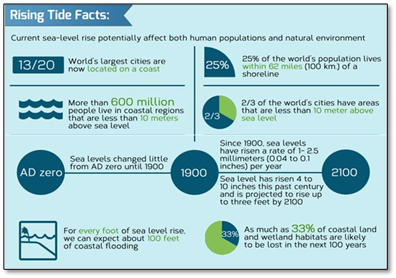
Measures to reduce or mitigate the destruction
As opposed to hard armouring solutions like sea walls and tetrapods, soft engineering options can be used to regain the lost beaches tackle the erosion. They are:
- Beach nourishment can be done using the material that is dredged from the navigation channel itself.
- Geotextile bags to be used to construct specific slope and height tolerances, to protect structures and to provide additional height to existing levee systems when floodwaters reach critical levels.
- Reef balls, which are submerged breakwaters deployed to the ocean floor and anchored, can help inshore stabilisation without affecting other areas. They can also act as a habitat for coral and fish.
Draft Master Plan for Delhi 2041 – Key Takeaways for Sustainable Urban Planning
In News
The Delhi Development Authority approved and released the draft Master Plan for Delhi 2041. The current master plan of Delhi — Master Plan 2021 — expires this year.
What Is Sustainable Urban Planning?
- Concerns over climate change, clean air and water, renewable energy and land use continue to draw attention to sustainability, particularly sustainable urban planning -- the developmental strategies and practices that ensure liveable, self-sustaining communities over the long term.
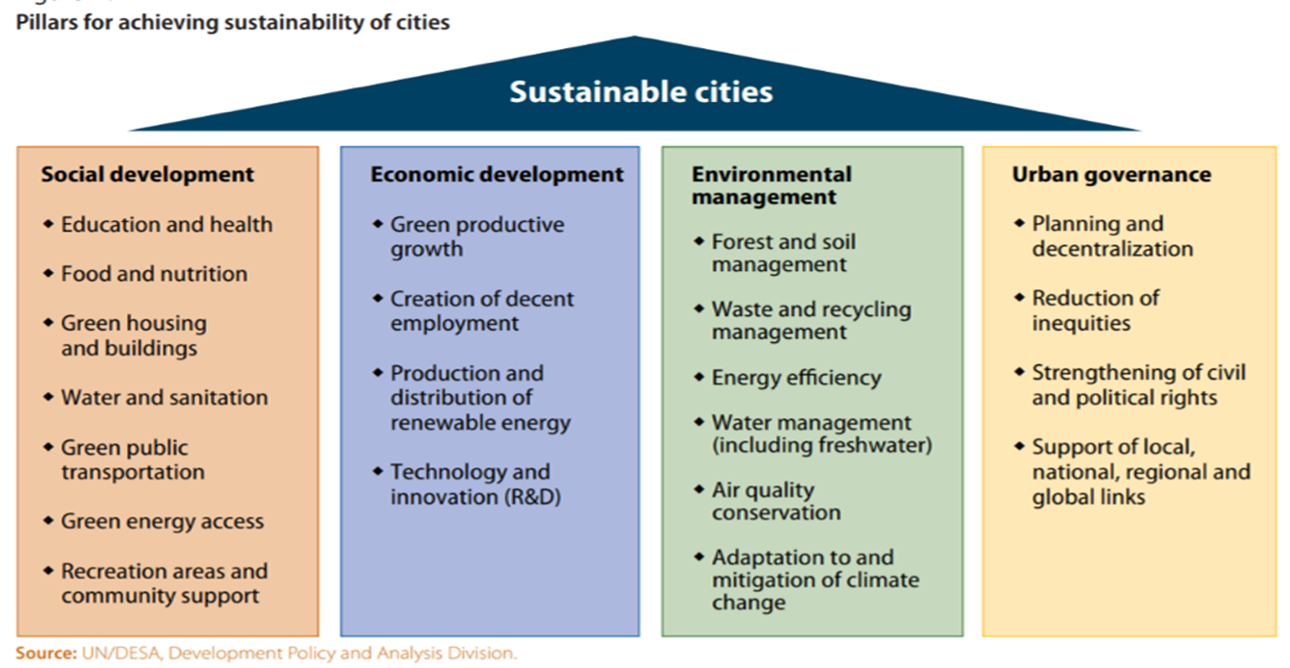
How does Draft Delhi Master Plan -2041 seek to achieve the pillars of Sustainable Urban Planning?
A master plan of any city is like a vision document by the planners and the land-owning agency of the city, which gives a direction to the future development. It includes analysis, recommendations, and proposals keeping in mind the population, economy, housing, transportation, community facilities, and land use.
Following table shows the enabling provisions of the Delhi Master Plan -2041 to achieve sustainable cities.
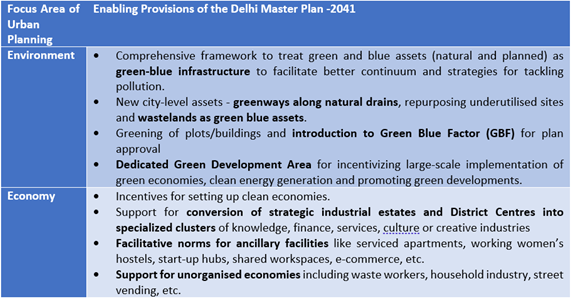
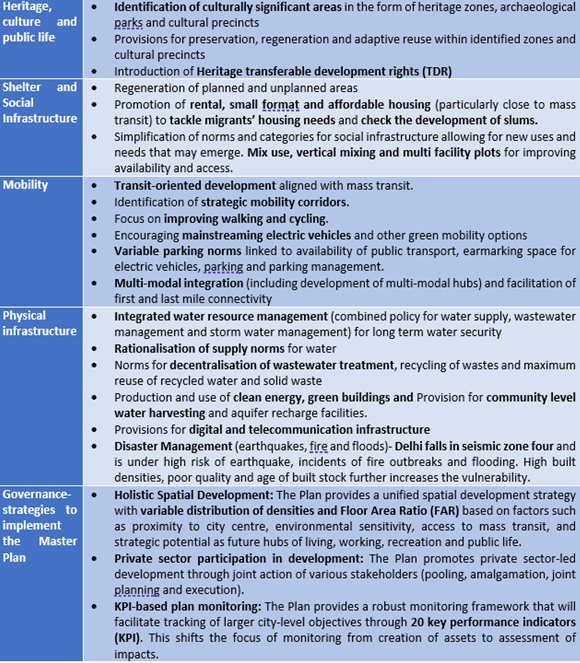
Conclusion
Cities’ sustainability is a broader concept which integrates social development, economic development, environmental management, and urban governance. In this regard, Draft Delhi Master Plan 2041 is an ambitious document. However various planning issues needs to be tackled. These include- Inaccurate population projections, lack of people’s participation, inadequate monitoring of changing conditions in city and data gaps, less responsive planning, and the weak implementation, enforcement, and monitoring of the planned strategies. The current COVID-19 pandemic further demands a holistic, inclusive, and decentralised planning to achieve sustainable, liveable cities.
Question: Analyse Master Plan for Delhi 2041 with reference to sustainable urban planning specific to Indian cities.
Sources-
https://dda.org.in/pdf/july13/Final%20MPD%202041%20-%20e%20Gazette_%20English.pdf
https://www.un.org/en/development/desa/policy/wess/wess_current/wess2013/Chapter3.pdf
https://in.one.un.org/page/sustainable-development-goals/sdg-11/
https://indianexpress.com/article/explained/delhi-master-plan-green-blue-policy-dda-6587961/
https://www.orfonline.org/research/delhi-master-plan-2021-41-towards-a-peoples-city/
This Day in History - International Day of Yoga
June 21 has been proclaimed as the International Day of Yoga by the United Nations. The International Day of Yoga celebrated since the year 2015, aims to raise awareness worldwide of the many benefits of practicing yoga. Yoga, an ancient physical, mental and spiritual practice, originated in India and word ‘yoga’, derived from Sanskrit, means to join or to unite, symbolising the union of body and mind. The World Health Organization mentions yoga as a means to improve health in its Global action plan on physical activity 2018–2030: more active people for a healthier world. Recognizing the important role of Yoga, this year’s commemoration of the International Day of Yoga focuses on “Yoga for well-being” - how the practice of Yoga can promote the holistic health of every individual.

Image of the Day- Miyazaki mangoes
This is the image of Miyazaki mangoes. Miyazaki mangoes are said to be one of the most expensive breeds of mangoes in the world. Also known as an egg of the sun, the Miyazaki mangoes were sold at ₹2.70 lakh per kilogram in the international market last year. The mangoes are grown in Japan's Miyazaki city. The mango is over 350 grams in weight and has a 15% or higher sugar content. These mangoes are rich in antioxidants and contain beta-carotene and folic acid, which is great for people that need help with tired eyes. They are grown during the peak harvest between April and August.
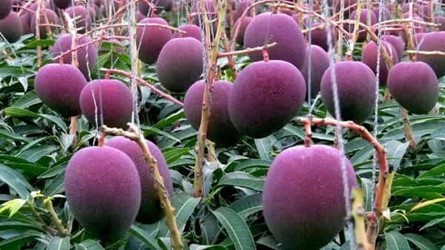
Global Trends 2020 Report
- Context: UNHCR releases its flagship Global Trends 2020 Report.
- Key Highlights of the Report:
- UNHCR has urged world leaders to step up their efforts to foster peace, stability and cooperation to halt and begin reversing a decade-long trend of surging displacement driven by violence and persecution.
- The report highlights important data:
- 4 million people forcibly displaced globally- 4% increase from 2019.
- 2020 is the ninth year of uninterrupted rise in forced displacement worldwide.
- More than two thirds of all people who fled abroad came from five countries: Syria (6.7 million), Venezuela (4.0 million), Afghanistan (2.6 million), South Sudan (2.2 million) and Myanmar (1.1 million).
- Vast majority of world’s refugees, nearly 9 in 10 refugees, are hosted by countries neighboring crises areas and low & and middle-income countries. The Least Developed Countries provided asylum to 27 per cent of the total.
- For the seventh year in a row, Turkey hosted the largest refugee population worldwide (3.7 million), followed by Colombia, Pakistan, Uganda, and Germany.
Primary source: https://www.unhcr.org/news/press/2021/6/60ca09a74/unhcr-world-leaders-must-act-reverse-trend-soaring-displacement.html
Disability Early Intervention Centers (DEIC)
- Context: Ministry of Social Justice and Empowerment has launched 14 cross disability early intervention centers across the country.
- The services provided at the DEIC include screening of children and referral to appropriate rehabilitative care; speech therapy, occupational therapy, and physiotherapy; parental counselling, training and peer counselling.
- Early childhood [0-6 years] is a time of remarkable brain development and thus early intervention can provide specialized support and services for infants and young children at-risk or with disability or developmental delay.

Primary source: https://www.thehindu.com/news/national/centre-opens-14-disability-early-intervention-centres/article34841209.ece
Picture source: https:// www.google.com/url
sa=i&url=https%3A%2F%2Fwww.facebook.com
https://www.apd-india.org/programs/early-intervention
Indian Certification of Medical Devices (ICMED) Plus Scheme
- Context: Quality Council of India (QCI) and the Association of Indian Manufacturers of Medical Devices (AiMeD) have added features to the ICMED Scheme of 2016 for Certification of Medical Devices.
- The ICMED 13485 PLUS scheme will undertake verification of the quality, safety, and efficacy of medical devices.
- It is the first of its kind scheme designed to integrate the Quality Management System components and product-related quality validation processes via witness testing of products with reference to the defined product standards and specifications.
- This scheme will be an end-to-end quality assurance scheme for the medical devices sector in India.
Primary source: https://economictimes.indiatimes.com/small-biz/sme-sector/qci-launches-icmed-plus-scheme-with-new-features/articleshow/83708461.cms
How green are India’s agri-exports? - IE
Essence: Agri-exports touched $41.8 billion in FY 2020-21, registering a growth of 18 per cent over the previous year. However, even these exports fall much short of the target of $60 billion that the government set out to achieve by 2022. In this context, the article discusses whether this growth rate can be sustained over a longer period, and the implications it has for Indian agriculture.
Why you should read this article?
- Know about the composition of the various agri-commodity exports and understand why the surge in exports of rice and sugar may not be sustainable.
- Have a brief overview of trends in value of agri exports and imports and agri trade as a percentage of GDP and understand the need to review current agri-trade policies and accompanying tariff structures.
- Identify reforms required in the entire gamut of rice and sugar systems from their MSP/FRP to their production in an environmentally sustainable manner.
Article Link: https://indianexpress.com/article/opinion/columns/how-green-are-indias-agri-exports-7368002/
Global capital racing towards clean energy- HBL
Essence: The International Energy Agency (IEA) roadmap to cut emissions and achieve the Paris goal requires massive investment to meet its targets. For this, Net Zero Emissions (NZE) requires expanding its annual investment in transmission and distribution grid along with increasing annual energy investment. Global capital is moving towards more profitable clean energy, India is experiencing the effects of this shift (absence of international bidder in India’s domestic coal bidding). This implies that India needs to accelerate its transition to renewable energy and firming capacity as availability of international capital is drying up and increasing investment in more bankable renewable energy, firming capacity, and grid modernisation. India should avoid the myth of ‘second life’ coal for environmental and financial risks involved. And need to design a policy which incorporate environment and climate risk management in finance sector for a more sustainable economy.
Why you should read this article?
- To get an overview of IEA net zero emissions roadmap and what we need to do to achieve its targets.
- How global capital shift towards renewable energy is impacting India and what India needs to do in its response?
Article Link: https://www.thehindubusinessline.com/opinion/global-capital-racing-towards-clean-energy/article34842362.ece
How Shirish Apte Rejuvenated A Traditional Water System In Maharashtra
Background Story:
- Traditional Water System called as Malguzari tanks provided water for irrigation and increased the availability of fish for local consumption.
- Malguzaars constructed, owned and maintained these water tanks but things changed when the Malguzari/Zamindari system was abolished.
- The tanks was left to rot due to lack of maintenance as the maintenance work was caught between the Malguzaars and the state government.
- No one took heed of this and the tanks remained unmaintained until 2008 when Shirish Apte entered the picture.
Contribution of Shirish Apte and community:
- He had always had a great interest in water conservation and decided to initiate the process of rejuvenating these tanks.
- With monetary support from the government and community support, he de-silted the tank to remove the fine sand in all the tanks.
Output of the exercise:
- Rejuvenation work helped in recharging groundwater levels.
- It increased agricultural output and fish production in the area.
- Employment levels have also increased because of this.
Lessons from the exercise:
- Bigger is not necessarily better: The revival of the Malguzaari tanks proved that cheaper and simpler methods for water conservation is more effective than the construction of big dams.
- Community participation and ownership is key to bring grassroot changes.
Quote:
- Alone we can do so little; together we ca do so much: Hellen Keller
Share the article
Get Latest Updates on Offers, Event dates, and free Mentorship sessions.

Get in touch with our Expert Academic Counsellors 👋
FAQs
UPSC Daily Current Affairs focuses on learning current events on a daily basis. An aspirant needs to study regular and updated information about current events, news, and relevant topics that are important for UPSC aspirants. It covers national and international affairs, government policies, socio-economic issues, science and technology advancements, and more.
UPSC Daily Current Affairs provides aspirants with a concise and comprehensive overview of the latest happenings and developments across various fields. It helps aspirants stay updated with current affairs and provides them with valuable insights and analysis, which are essential for answering questions in the UPSC examinations. It enhances their knowledge, analytical skills, and ability to connect current affairs with the UPSC syllabus.
UPSC Daily Current Affairs covers a wide range of topics, including politics, economics, science and technology, environment, social issues, governance, international relations, and more. It offers news summaries, in-depth analyses, editorials, opinion pieces, and relevant study materials. It also provides practice questions and quizzes to help aspirants test their understanding of current affairs.
Edukemy's UPSC Daily Current Affairs can be accessed through:
- UPSC Daily Current Affairs can be accessed through Current Affairs tab at the top of the Main Page of Edukemy.
- Edukemy Mobile app: The Daily Current Affairs can also be access through Edukemy Mobile App.
- Social media: Follow Edukemy’s official social media accounts or pages that provide UPSC Daily Current Affairs updates, including Facebook, Twitter, or Telegram channels.

